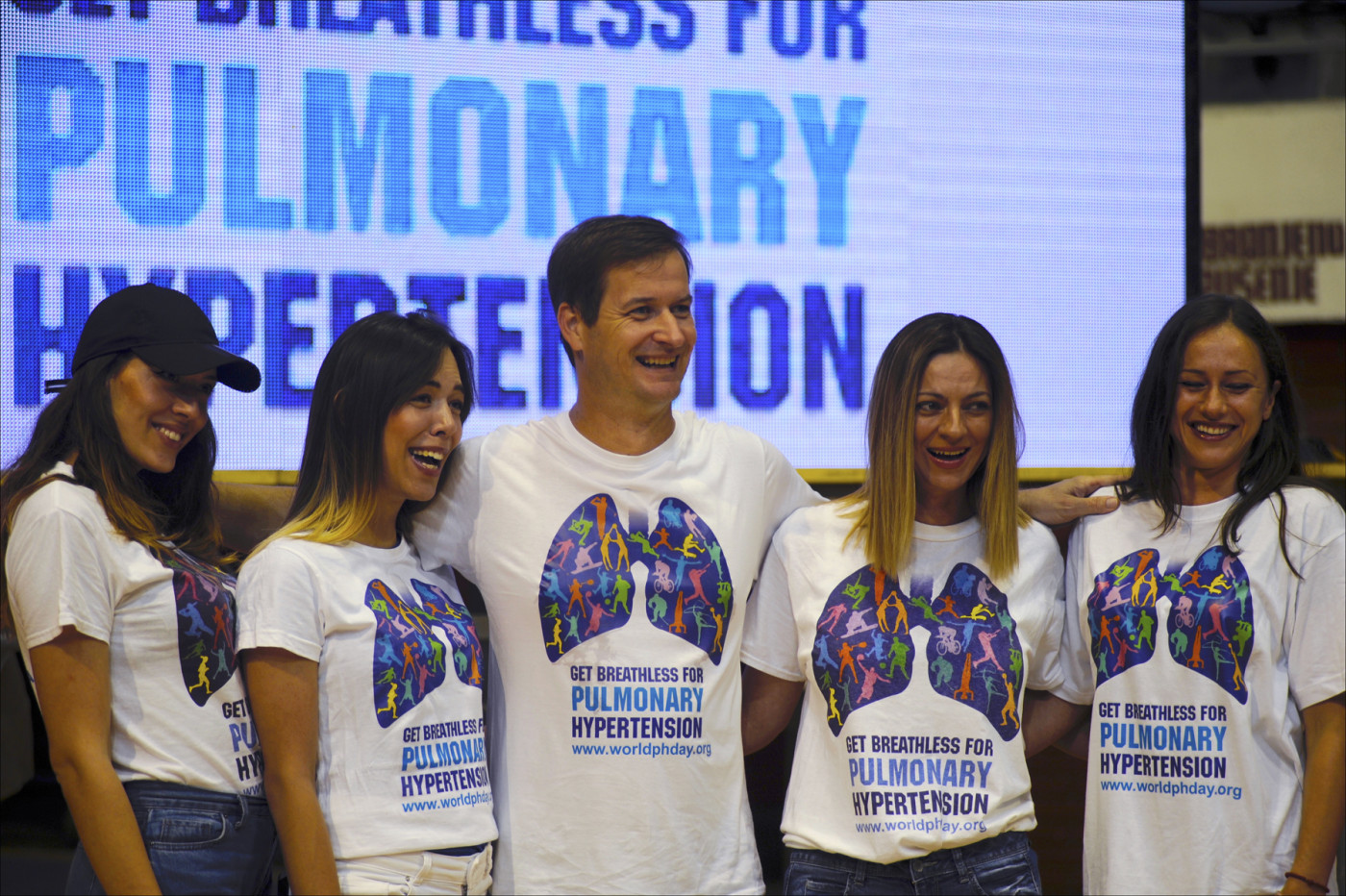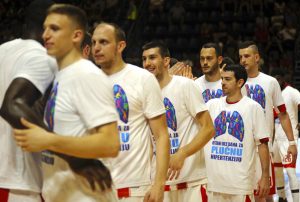PAH Patients in Serbia Organize to Raise Awareness

Serbian PH patients attend a basketball game in Belgrade to raise public awareness of their disease. (Photo by Larry Luxner)
Three years ago, Miloš Lazić taught physical education at a Belgrade elementary school while playing for Serbia’s championship water polo team.
These days, Lazić is still a teacher — but he can barely take 10 steps without getting out of breath.
Lazić, a big, muscular 37-year-old with tattoos on his biceps, has pulmonary arterial hypertension (PAH). He recalls going from healthy to sick literally overnight.
“One day — it was Dec. 19, 2015 — I was training in the pool and didn’t feel very well,” he said. “I passed out and went into a coma for four days. The doctors said I was fighting for my life. While I was in the hospital, they did an analysis and found out it was PAH.”
He added: “I had never heard about this disease before. I was confused and scared, asking a lot of questions and looking for answers.”
Lazić and several other Serbs spoke with Pulmonary Hypertension News about their rare disease during a recent gathering at a Belgrade restaurant. All belong to the patient advocacy group PHA Serbia, which was founded in September 2015 by novelist Danijela Pešić and her friend, marketing manager Mirko Glavinić.
“I met Mirko 10 years ago when his mother and I were in the same hospital room. I was very ill,” said Pešić, 42, who’s been in and out of hospitals for much of her life. “I promised Mirko that if I survived, I would help everybody with PAH.”
Government authorizes new therapies
Pešić estimates that 350 of Serbia’s seven million inhabitants live with PAH at any given time. In Pešić’s case, the disease is secondary since she also has a congestive heart defect.
“In Serbia, the prognosis for this disease is generally not very good. Without drugs, people live less than three years,” she said, noting that since 2015, only one basic treatment, Pfizer’s Revatio (sildenafil citrate), is free and available through Serbia’s national health insurance program. But Revatio is effective only for the first phase of the illness.
Thanks to the persistent efforts of PHA Serbia, as well as the country’s First Lady Tamara Vucić, however, the government will soon authorize the distribution of several more medications, including Actelion Pharmaceuticals’ Tracleer (bosentan), Bayer’s Adempas (riociguat), and Letairis (ambrisentan), which is marketed in Europe by GlaxoSmithKline.
“The medicine only helps you deal with the sickness, to get through the hard times. The only real cure is a lung transplant,” said Pešić, who is also secretary of PHA Europe — a Vienna-based umbrella group for 39 national pulmonary hypertension associations in 33 countries.
Yet Serbia lacks a transplant center, she said. And because of religious prejudices and traditions rooted in fear, “people here are not that willing to give their organs away. Not one patient with PAH has ever had a transplant. But we hope that will change in the near future.”
In the meantime, Serbs who have PAH are profoundly affected — especially due to economic stagnation following the Balkan wars of the 1990s, and the global sanctions those wars sparked.
“One of the most heartbreaking problems is that children end up actually having to sleep in hospitals,” Pešić said. “Parents come from out of town and have nowhere to stay, so they sleep in their cars. Our organization rents out a small apartment for free in Belgrade, where there’s enough space for four or five people.”
Explaining PAH to healthy people
Pešić, who recently attended the Pulmonary Hypertension Association’s 2018 annual conference in Orlando, Florida, said the two things she must avoid at all costs are sports and stress.
“I can’t run. I can’t swim. I have shortness of breath, every day I need 14 hours of oxygen, and I never go alone on trips,” she said. “I don’t know what it’s like to be healthy.”
One of the most frustrating things, Pešić said, is explaining what PAH is like to friends and acquaintances who are ignorant of the disease.
“Even when they say they understand, I see that they don’t really understand,” she said. “Almost every PAH patient looks perfectly healthy. We tell people we have high blood pressure in the lungs. If they want to know how it feels, imagine breathing through a straw in your mouth while walking, and with your nose closed.”
College student Andjela Obradović, 21, has had PAH for the last five years.
“My symptoms started suddenly. I felt tired just from climbing to the third floor, and walking fast,” she said. “I thought it was because of poor conditioning, but when they didn’t go away, I suspected something was wrong.”
How do you raise awareness for PH? How do you raise awareness for PH? Share it in our PH forums. Sign up today!
Two months later, the diagnosis came back: PAH. By that time, the young woman’s pulmonary blood pressure was 80 mmHg (millimeters of mercury) — more than four times the 8-20 mmHg in healthy people.
“That’s when my struggle began, the struggle to stay alive. Meanwhile, my pressure increased to 130 mmHg and I started to feel chest pains, eventually spreading to my neck,” Obradović said.
Thanks to help from PHA Serbia, Obradović gained access to Tracleer, and later prostacyclines.
“Prostacyclines are considered one of the best drugs for PAH,” said Obradović, who gets considerable assistance and moral support from her older sister, Nataša. “No medications will completely cure it, and the ones I use prevent the disease from progressing. For the last two years, I have felt much better, the symptoms have decreased, and my pressure has dropped to 70 mmHg. The most important thing is to think positively.”
Basketball stars help get message out
Lazić said PAH has changed his life deeply, though more psychologically than physically.
“It’s had an impact on my whole family. Once or twice a month, I fall into some form of depression. I have two daughters and it’s really hard because I can’t play with them or pick them up,” he said. “But working helps a lot. I’ve gotten a lot of support from colleagues.”
In addition, he said, the 24 kids in the class he teaches “all know what I have, and they come to all our events to support me. They give me lots of energy.”
One such event was a June 7 basketball game between Serbia’s two leading teams: KK Partizan and KK Crvena Zvezda (Red Star). The competition, which took place before a packed audience at Belgrade’s Hala Aleksandar Nikolić sports arena, was notable for the fact that the entire Red Star team briefly donned PHA Serbia T-shirts.
In addition, a huge electronic billboard advertised public service announcements about the disease as cheerleaders performed throughout the nationally televised game.
“Some of our events cost a lot of money, so we try to find pharmaceutical companies to donate money,” said Pešić’s friend, Mirko Glavinić. “For this event, it would have cost us €50,000 [about $58,000], but our cost was zero because Red Star understood what we were doing and wanted to help us out.”
Meanwhile, Pešić’s health has significantly improved thanks to her participation in a clinical study of Actelion’s Opsumit (macitentan).
“Before this medicine, I would walk 10 meters and be out of breath. My life has dramatically changed for the better because of this new drug,” she said, adding that in the long run, only a lung transplant will cure her. “For now, I feel great. But I know that one day, I will need it.”











